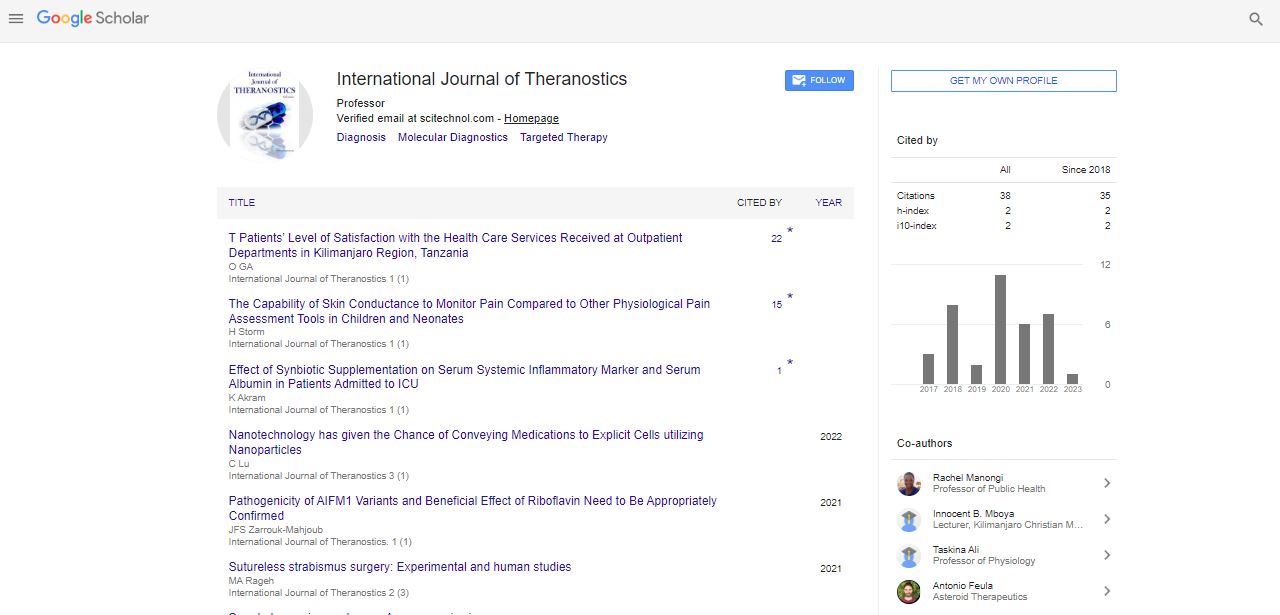Short Communication, Ijt Vol: 12 Issue: 3
Nanotechnology's Role in Transforming Diagnostics and Therapeutics
Jona Barragán*
1Department of Pharmaceutical Technology, University of Coimbra, Coimbra, Portugal
*Corresponding Author: Jona Barragán,
Department of Pharmaceutical
Technology, University of Coimbra, Coimbra, Portugal
E-mail: jonabarragain7@ff.uc.pt
Received date: 30 August, 2023, Manuscript No. IJT-23-117615;
Editor assigned date: 01 September, 2023, PreQC No. IJT-23-117615 (PQ);
Reviewed date: 15 September, 2023, QC No. IJT-23-117615;
Revised date: 22 September, 2023, Manuscript No. IJT-23-117615 (R);
Published date: 02 October, 2023, DOI: 10.4172/IJT.1000138
Citation: Barragán J (2023) Nanotechnology's Role in Transforming Diagnostics and Therapeutics. Int J Theranostic 12:3.
Abstract
The integration of nanotechnology and biology has opened up a realm of possibilities in the field of medicine. This interdisciplinary frontier, known as nano-bio interaction, is fundamentally transforming the way we diagnose and treat diseases. One of the most promising outcomes of this interaction is the advancement of theranostics-a sophisticated approach that combines diagnostics and therapy.
Description
The integration of nanotechnology and biology has opened up a realm of possibilities in the field of medicine. This interdisciplinary frontier, known as nano-bio interaction, is fundamentally transforming the way we diagnose and treat diseases. One of the most promising outcomes of this interaction is the advancement of theranostics-a sophisticated approach that combines diagnostics and therapy. In this article, we explore the fascinating world of nano-bio interaction and its profound impact on the field of theranostics [1].
Nano-bio interaction refers to the intricate interplay between nanoscale materials and biological systems. At the heart of this phenomenon are nanoparticles, typically ranging from 1 to 100 nanometers in size. These nanoparticles are engineered to interact with biological entities, such as cells, proteins, and DNA, in highly specific ways. The outcome of these interactions can be harnessed for various applications, including diagnostics and therapeutics [2].
The influence of nano-bio interaction on theranostics
One of the key contributions of nano-bio interaction is the ability to precisely target specific biological molecules or cells. Nanoparticles can be functionalized with ligands or antibodies that bind to particular receptors on the surface of target cells, enhancing the accuracy of diagnostics and treatment [3,4].
Nanoparticles have revolutionized medical imaging techniques. For example, superparamagnetic iron oxide nanoparticles are used to enhance Magnetic Resonance Imaging (MRI), while quantum dots enable highly detailed fluorescent imaging. These improvements offer unparalleled insights into disease processes. Nano-bio interactions have opened new avenues for drug delivery [5,6].
Nanoparticles can encapsulate drugs, protecting them from degradation and ensuring controlled release at the target site. This not only increases drug efficacy but also minimizes side effects. The precision of nanoscale interactions allows for the development of personalized treatment strategies. By tailoring therapies based on an individual's unique biology, nanotechnology is ushering in a new era of personalized medicine. The most exciting application of nano-bio interaction is in theranostics. Theranostics combines diagnostic and therapeutic elements into a single platform, enabling real-time monitoring of treatment efficacy. For instance, nanoparticles can deliver a therapeutic payload while simultaneously providing imaging capabilities to track treatment progress [7,8].
Real-world applications of nano-bio interaction in theranostics
Nanoparticles are being used to detect and treat cancer in groundbreaking ways. Gold nanoparticles, for example, can deliver chemotherapy drugs directly to cancer cells while providing a contrast agent for imaging. This reduces collateral damage to healthy tissues. Magnetic nanoparticles can be used for targeted delivery of drugs to blood vessels. They can also serve as contrast agents for imaging the vasculature, assisting in the diagnosis and monitoring of cardiovascular diseases. Nanoparticles are showing promise in the management of neurodegenerative disorders. They can deliver therapeutic agents to the brain and act as contrast agents for precise imaging in conditions like Alzheimer's disease. Nano-bio interactions have opened new possibilities in the early detection and treatment of infectious diseases. Nanoparticles can be engineered to detect specific pathogens and deliver antiviral or antibacterial agents [9,10].
Conclusion
Nano-bio interaction is a dynamic field with the potential to revolutionize healthcare. Its impact on theranostics is particularly remarkable, ushering in a new era of precise diagnostics and targeted treatments. As research and development in this field continue to evolve, the future of medicine looks increasingly personalized, efficient, and effective. By harnessing the unique capabilities of nanoparticles, we are on the brink of realizing the full potential of nano-bio interaction in improving patient outcomes and the overall quality of healthcare.
References
- Moghimi SM, Hunter AC, Murray JC (2005) Nanomedicine: current status and future prospects. FASEB J 19(3):311-330.
- Freitas Jr RA (2005) What is nanomedicine? Nanomedicine: nanotechnology Biol Med 1(1): 2-9.
- Farokhzad OC, Langer R (2006) Nanomedicine: developing smarter therapeutic and diagnostic modalities. Adv Drug Deliv Rev 58(14):1456-1459.
- McNeil SE (2005) Nanotechnology for the biologist. J Leukoc Biol 78(3): 585-594.
- Salata O (2004) Applications of nanoparticles in biology and medicine. J Nanobiotechnol 2(1): 3.
- Bunz UHF, Rotello VM (2010) Gold nanoparticle-fluorophore complexes: sensitive and discerning “noses” for biosystems sensing. Angew Chem Int Ed 49(19):3268-3279.
- Holl MMB (2009) Nanotoxicology: a personal perspective. Wiley Interdiscip Rev Nanomed Nanobiotechnol 1(4):353-359.
- Hobson DW (2009) Commercialization of nanotechnology. Wiley Interdiscip Rev Nanomed. Nanobiotechnol 1(2):189-202.
- Cho EC, Zhang Q, Xia Y (2011) The effect of sedimentation and diffusion on cellular uptake of gold nanoparticles. Nat Nanotechnol 6(6):385-391.
- Brown PH, Schuck P (2006) Macromolecular size-and-shape distributions by sedimentation velocity analytical ultracentrifugation. Biophys J 90(12): 4651-4661.
 Spanish
Spanish  Chinese
Chinese  Russian
Russian  German
German  French
French  Japanese
Japanese  Portuguese
Portuguese  Hindi
Hindi 